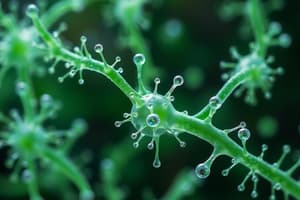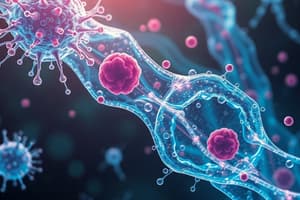Podcast
Questions and Answers
Transient flora can persist in the body for several months before disappearing.
Transient flora can persist in the body for several months before disappearing.
True (A)
Bodily fluid transmission does not include saliva.
Bodily fluid transmission does not include saliva.
False (B)
Airborne transmission involves pathogens traveling farther than 1 meter.
Airborne transmission involves pathogens traveling farther than 1 meter.
True (A)
Indirect contact transmission only occurs through personal interactions between individuals.
Indirect contact transmission only occurs through personal interactions between individuals.
Normal flora can act as opportunistic pathogens if the balance of the microbiome is disturbed.
Normal flora can act as opportunistic pathogens if the balance of the microbiome is disturbed.
Eukaryotes are organisms that lack a mature nucleus.
Eukaryotes are organisms that lack a mature nucleus.
Viruses can be classified as prokaryotic organisms.
Viruses can be classified as prokaryotic organisms.
Prions consist of nucleic acids surrounded by a protein coat.
Prions consist of nucleic acids surrounded by a protein coat.
Sporulation is the process by which vegetative bacteria form spores.
Sporulation is the process by which vegetative bacteria form spores.
Algae and fungi are both classified as prokaryotic organisms.
Algae and fungi are both classified as prokaryotic organisms.
Archaea are unicellular organisms that thrive in extreme environments.
Archaea are unicellular organisms that thrive in extreme environments.
Bioremediation involves utilizing microbes to break down environmental contaminants.
Bioremediation involves utilizing microbes to break down environmental contaminants.
Protozoa are primarily multicellular organisms.
Protozoa are primarily multicellular organisms.
When environmental conditions improve, the vegetative form changes into spore form.
When environmental conditions improve, the vegetative form changes into spore form.
Lysosomes contain digestive enzymes that help break down particles like bacteria.
Lysosomes contain digestive enzymes that help break down particles like bacteria.
The Golgi Apparatus serves as the primary power site for ATP production in the cell.
The Golgi Apparatus serves as the primary power site for ATP production in the cell.
Specific defense mechanisms provide a general resistance to all harmful agents.
Specific defense mechanisms provide a general resistance to all harmful agents.
Antibody-mediated immunity is primarily produced by T-cells.
Antibody-mediated immunity is primarily produced by T-cells.
Inflammation is a nonspecific defense mechanism characterized by redness, hotness, swelling, and pain.
Inflammation is a nonspecific defense mechanism characterized by redness, hotness, swelling, and pain.
Neutrophils are large agranular leukocytes involved in phagocytosis.
Neutrophils are large agranular leukocytes involved in phagocytosis.
Plasma cells are responsible for the production of antibodies.
Plasma cells are responsible for the production of antibodies.
Fever is a symptom characterized by generalized vasodilation and increased capillary permeability.
Fever is a symptom characterized by generalized vasodilation and increased capillary permeability.
Resident flora refers to the normal flora that remains throughout a person's life.
Resident flora refers to the normal flora that remains throughout a person's life.
Flashcards
Microbiology
Microbiology
The study of organisms too small to be seen without magnification.
Microorganisms
Microorganisms
Organisms like bacteria, viruses, fungi, and algae that are too small to be seen without a microscope.
Taxonomy
Taxonomy
The formal system of organizing, classifying, and naming living organisms.
Bacteria
Bacteria
Signup and view all the flashcards
Fungi
Fungi
Signup and view all the flashcards
Endospores
Endospores
Signup and view all the flashcards
Protozoa
Protozoa
Signup and view all the flashcards
Prions
Prions
Signup and view all the flashcards
Transient Flora
Transient Flora
Signup and view all the flashcards
Opportunistic Pathogens
Opportunistic Pathogens
Signup and view all the flashcards
Direct Contact Transmission
Direct Contact Transmission
Signup and view all the flashcards
Vector Transmission
Vector Transmission
Signup and view all the flashcards
Water-borne Transmission
Water-borne Transmission
Signup and view all the flashcards
Germination
Germination
Signup and view all the flashcards
Mitochondria
Mitochondria
Signup and view all the flashcards
Ribosomes
Ribosomes
Signup and view all the flashcards
Endoplasmic Reticulum (ER)
Endoplasmic Reticulum (ER)
Signup and view all the flashcards
Lysosomes
Lysosomes
Signup and view all the flashcards
Inflammation
Inflammation
Signup and view all the flashcards
Nonspecific Defense Mechanisms
Nonspecific Defense Mechanisms
Signup and view all the flashcards
Cell-mediated Immunity
Cell-mediated Immunity
Signup and view all the flashcards
Antibody-mediated Immunity
Antibody-mediated Immunity
Signup and view all the flashcards
Normal Flora
Normal Flora
Signup and view all the flashcards
Study Notes
Microbiology
- Study of organisms too small to see without magnification, originated with microscope invention
- Microorganisms include bacteria, viruses, fungi, protozoa, helminths (worms), algae, and prions
Branches of Study
- Immunology
- Public health microbiology and epidemiology
- Food, dairy, and aquatic microbiology
- Biotechnology
- Genetic engineering and recombinant DNA technology
- Manipulating genes
Microbes' Roles
- Nutrient production and energy flow
- Decomposition
- Biotechnology (e.g., food, drug, vaccine production)
- Genetic engineering
- Bioremediation (cleaning up pollutants)
- Infectious disease
Classification of Microorganisms (Protists)
I - Cellular
- 1- Prokaryotes: Lack a nucleus or a well-defined nucleus. Includes archaea, bacteria, and blue-green algae
- 2- Eukaryotes: Have a nucleus. Includes algae (except blue-green), fungi, and protozoans
II - Non-Cellular
- Viruses, viroids, and prions
Taxonomy
-
Formal system for organizing, classifying, and naming living organisms
-
Bacteria: prokaryotic, unicellular organisms
-
Archaea: prokaryotic, unicellular organisms, thrive in extreme temperature and salt environments
-
Algae: eukaryotic, unicellular or multicellular organisms, often perform photosynthesis
-
Fungi: eukaryotic, often unicellular or multicellular organisms
-
Protozoa: eukaryotic, unicellular or multicellular organisms
-
Viruses: noncellular, seen only with electron microscopy, consist of nucleic acid (NA) surrounded by protein coat
Bacterial Life Cycle
- Exist in vegetative form (metabolically active and growing, able to cause infection).
- Under unfavorable conditions, some bacteria form endospores (a dormant, resistant form)
- Endospores can survive for years, and convert back to vegetative form when conditions improve
Cytoplasmic Organelles
- Mitochondria: Powerhouses of the cell, fluid-filled sacs, often containing ATP
- Ribosomes: Granules that synthesize proteins
- Endoplasmic Reticulum: Network of membranes for protein and lipid synthesis and transport
- Golgi Apparatus: Packages and ships cellular products
- Lysosomes: Contain digestive enzymes
- Centrioles: Involve in cell division
- Cilia: Small, hair-like structures responsible for moving substances across cell surface
- Flagella: Long structures facilitating cell movement
- Chloroplasts: In plants/algae, convert sunlight energy into chemical energy (photosynthesis)
Defense Mechanisms Against Infection
- Nonspecific: act against all harmful agents (e.g., skin, mucus membranes, immune system components)
- Specific: Target specific agents (e.g., immune response).
Modes of Transmission
- Contact: Direct physical (touching) or indirect (through a fomite)
- Droplet: Transmission of pathogens via respiratory droplets
- Airborne: Transmission of pathogens via airborne particles (greater than 1 meter)
- Water-borne/Food-borne: Pathogens transmitted via contaminated water or food
- Vector-borne: Transmission via an animal (e.g., insect)
Applied Microbiology
- Food production, alcoholic beverages, treatment of water supplies, pharmaceutical agents, agriculture, bioremediation, forensics, energy (e.g., ethanol, methane)
Studying That Suits You
Use AI to generate personalized quizzes and flashcards to suit your learning preferences.



